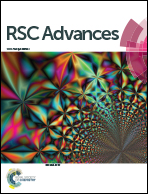The effects of Stone–Wales defects on the thermal properties of bilayer armchair graphene nanoribbons
Abstract
We investigate the influence of Stone–Wales (S–W) defects on the thermal properties of bilayer graphene nanoribbons (BGNRs) with armchair edges by nonequilibrium molecular dynamics simulations (NEMD). It is shown that an increasing number of S–W defects leads to a significant decrease of the thermal conductivity of BGNRs at room temperature. Moreover, the AA-stacked BGNRs have significantly higher thermal conductivity than that of the AB-stacked BGNRs for all S–W defect numbers. In the temperature range of 300–700 K, the S–W defects always have a weaker effect on heat transfer of AB-stacked BGNRs than AA-stacked BGNRs, which is closely related to their weaker anharmonic effects induced by structure defects. In addition, the simulation results are further explained by performing an analysis of phonon spectrum properties and phonon vibrational modes.



 Please wait while we load your content...
Please wait while we load your content...